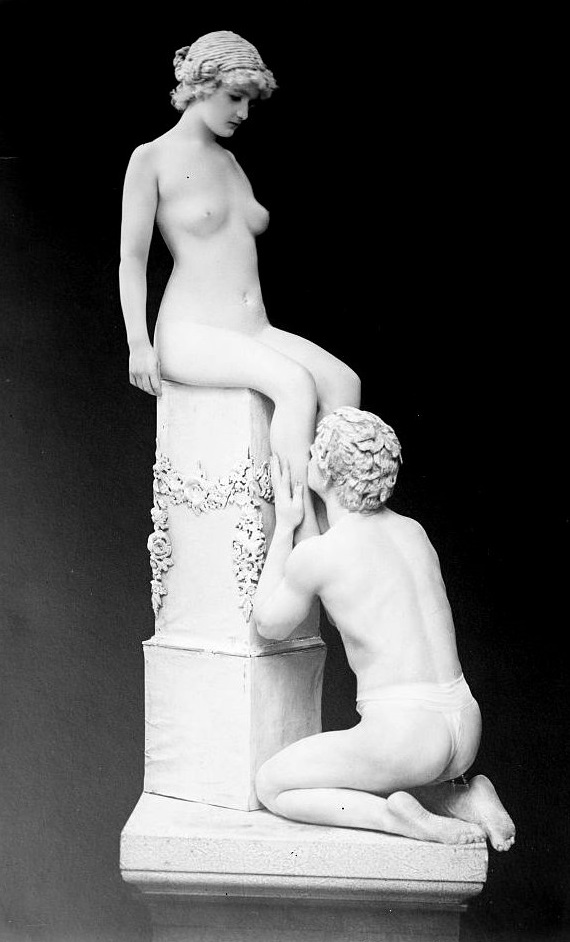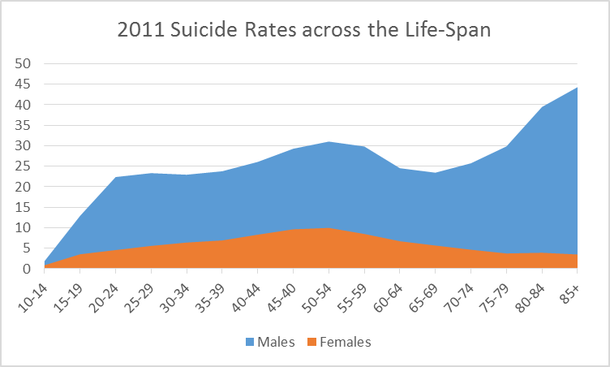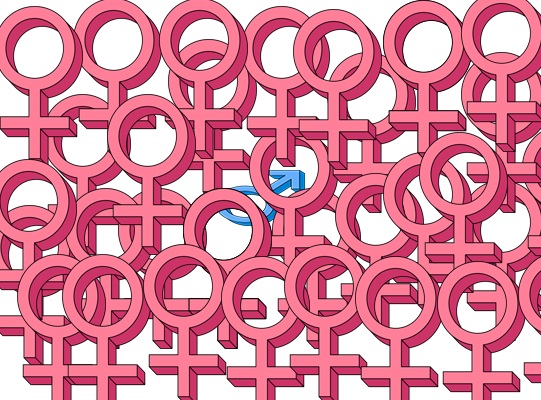By Peter Ryan

When we discuss men’s issues in the manosphere, the term “gynocentrism” is often attributed as the primary causal factor driving the marginalisation of men and boys in society. Understanding the nature of the force men are fighting, is a critically important step in developing effective strategies and possible solutions to the numerous issues men and boys are facing in society. Peter Wright at Gynocentrism.com1, defines and describes gynocentrism and discusses its cultural origins and biological underpinnings on his website.
Gynocentrism manifests itself in relationships and the culture in many ways. However, this is not always obvious. One of the powerful characteristics of gynocentrism is how subtle it is and how easily gynocentric bigotry can be disguised and hidden from our perception. Society is complex and often there are a multitude of variables involved in any activity, practice or set of behaviours etc. Gynocentrism can blend in with these other variables and the complexity of society can help push it into the background of our perception.
The biological drivers of gynocentrism2, also play a role in masking it from our perception. Gynocentrism is the product of superresponses to sexual and emotional superstimuli and these responses undoubtedly filter our perception, as well as produce the behaviours that give rise to gynocentrism. Intense cultural conditioning also plays a major role from cradle to grave, in training the brain to filter information through a gynocentric lens (the blue pill perspective). The gynocentric mobius strip is a readily observable social phenomenon.
As a result of these factors, there are examples in society where gynocentrism is obvious to many people (like radical feminism) and there are many examples where gynocentrism is not so obvious. There are also examples where an activity can be mistaken to be non-gynocentric and vice versa. It can often take years to train perception in adults to a point where gynocentrism can be readily identified (taking the red pill) and overcome the years of cultural conditioning and the acquired biological short circuits (the superresponses and positive feedback loops) that drive gynocentrism.
Gynocentrism is a slippery beast and defining it has been the subject of discussion in the manosphere (please see Paul Elam and Alison Tieman’s talk on this subject linked here3). If we are to slay the gynocentric dragon, then we must first develop a refined definition of gynocentrism and diagnostic criteria for identifying it in society and relationships. It is important to define problems as precisely as possible, so we can develop effective targeted solutions. This article will be the first in a series of articles exploring the nature of gynocentrism.
In this article I will present a refined definition of gynocentrism and provide a simple set of diagnostic criteria for identifying it in society and relationships. I will provide practical examples of the operation of this definition and criteria, then discuss whether certain aspects of the culture are gynocentric and then describe a model of measuring the intensity of gynocentrism in the culture. It is my hope that this article and the following series of articles, will assist people in the manosphere in explaining what gynocentrism is to people unfamiliar with the concept and in relation to men’s issues. Solving a social problem requires spreading an awareness of the problem and this in turn requires properly identifying what it is.
What Is Gynocentrism?
I define gynocentrism as the following: The set of elements of society and relationships that are directed by the intent to prioritise female well-being over male well-being, based solely or partly on the sex of the intended beneficiary(ies) being female and for which there are no equivalent efforts made to provide corresponding commensurate benefits to males.
I define well-being as the quality of the overall condition of the life of an individual or group, that is based on taking their mental and physical health and life satisfaction into consideration.
The diagnostic criteria that must be met for an element of society or relationships to be considered gynocentric are the following:
- The element must be driven by the intent to prioritise female well-being over male well-being.
- This intent must be solely or partly based on the sex of the intended beneficiary(ies) being female.
- There must be no equivalent efforts made to provide commensurate benefits to males for instances where female well-being is prioritised over male well-being.
Evaluating an element of society or relationships against these three criteria, requires some investigation to confirm the intent driving it and whether that intent is based on the sex of the group or individual that is meant to benefit from it. Quite often this information is overtly virtue signalled (like policies advocating female hiring quotas or domestic violence campaigns). On other occasions it is not and gynocentrism has to be identified through careful observation of the element in question and through a process of elimination.
The core belief that gynocentrism is associated with is female superiority. It is also associated with female entitlement mentality4. Gynocentrism is a form of bigotry based on sex and is not a morally justifiable aspect of society or relationships. For those people that have doubts, please substitute “male” with black people and “female” with white people in the definition of gynocentrism, or simply reverse the sexes. Those individuals that appeal to nature to justify gynocentrism, should look up what a naturalistic fallacy is. We can appeal to nature to justify rape and that does not morally justify it or mean that we should accept it. Gynocentrism is not defensible and should not be normalised in the culture.
I called myself “theantigynocentrist” for this very reason and because I wanted to make it abundantly clear exactly what I am fighting against. Feminism is the political manifestation of gynocentrism and is just the tip of the iceberg of the problem I am standing up against. There are those that would prefer men just stop at feminism and not question anything beyond that. Heaven forbid men get the idea in their heads that they deserve to be treated fairly (The scene from Oliver Twist asking for more comes to mind. How dare men ask to be treated fairly! The horror.). Some so-called “antifeminists” are worried the gravy train of exploiting men might stop if men look beyond feminism and go to the root of the problem.
Armed with this refined definition of gynocentrism and the diagnostic criteria described earlier, it becomes possible to identify gynocentrism in society and relationships in a tangible way. What gynocentrism is and is not, can be illustrated with the following examples:
Example 1.
A man and a woman are both involved in a car accident. The woman is critically injured and at risk of death without immediate medical treatment and the man is walking around conscious with a few scratches and is in a stable condition. The woman is treated first.
This is not an example of gynocentrism. The paramedics prioritise the woman’s well-being over the man’s well-being, as the woman is objectively in greater need of immediate medical assistance and the man is not.
Example 2.
A man and a woman are both involved in a car accident. The man is critically injured and at risk of death without immediate medical treatment and the woman is walking around conscious with a few scratches and is in a stable condition. The woman is treated first, as the paramedics mutter women and children first.
This is gynocentrism. The paramedics prioritise the woman’s well-being over the man’s well-being, even though the man is objectively in greater need of immediate medical assistance.
Example 3.
A family celebrates Mother’s Day and then celebrates Father’s Day later in the same year.
This is not gynocentrism. There is a corresponding day for male parents.
Example 4.
An organisation celebrates International Women’s Day and does not celebrate International Men’s Day.
This is gynocentrism. There is no corresponding day of celebration for men at this organisation.
Example 5.
A company decides to implement a female hiring quota for their board that requires 50% of positions to be given to female candidates. The number of applicants is 90% male.
This is gynocentric. Female candidates are prioritised over male candidates and this is because they are female.
Example 6.
A company decides to implement a female hiring quota for their board that requires 50% of positions to be given to female candidates and 50% of positions to be given to male candidates. The number of applicants is 90% male.
This is gynocentric. Whilst men are given a corresponding benefit, this benefit is not commensurate with the benefit given to women. 90% of the applicants are male and yet only half of the positions are available to those men.
Example 7.
A company decides to implement a multifaceted policy to boost gender diversity on their board. The company develops a mentoring network for senior female managers to mentor younger women and offers them secondment opportunities in higher positions. An equivalent mentoring network is set up for men and the same secondment opportunities are offered. The company makes changes to provide equal amounts of maternity and paternity leave to male and female employees. Flexible work hours, subsidised childcare located at the workplace and the option to work remotely from home three days of the week, is provided to both male and female employees.
Whilst there might be other problems with the feasibility of this policy, it is not gynocentric. The intent driving this policy does not prioritise female well-being over male-wellbeing. The benefits given to women and men are balanced and the aim to prioritise gender diversity is not skewed in favour of either sex. However, the initiatives in this policy may increase female representation at senior managerial levels and have a flow on effect at board level.
Example 8.
A man and a woman with equal salary go out for dinner on a date. During the date the woman repeatedly makes it known they expect chivalry from the man. Despite desiring to pay half the bill, the man pays the entire bill to gain female approval and bows to the pressure to conform.
This is gynocentric. The woman’s well-being is prioritised over the man’s well-being because she is female.
Example 9.
A man and a woman with equal salary go out for dinner on a date. During the date the woman and the man chat and have a great relaxing time. The man has a generous character and enjoys giving gifts to people. Out of his own personal desire and generosity, he pays the entire bill. He feels very happy about this and suffers no detriment to his health and does not put his finances in jeopardy. The benefit to his well-being in his individual case, is commensurate with the benefit to the woman’s well-being.
This is not gynocentric. In this case the man is acting in an authentic manner that makes him happy and improves his well-being and his well-being is not given a secondary priority. Not all men will react the same way to the same situation. What may decrease one man’s well-being, may actually increase another man’s well-being. Men must be their authentic selves (provided they do not harm others, including themselves, unless in self-defence).
Example 10.
A man and a woman with equal salary go out for dinner on a date. During the date the woman and the man chat and have a great relaxing time. The man has a generous character and enjoys giving gifts to people. Out of his own personal desire and generosity he pays the entire bill. They go out on further dates to expensive restaurants and the man continues to pay the whole bill on each occasion. He also buys his date expensive jewellery every month. The man starts to fall into debt and starts to default on payments. He becomes stressed and depressed.
This is gynocentric. In this case the man may be getting some short-term satisfaction out of being so generous, but in general his life satisfaction and mental health are declining because of the growing debt he is accumulating. The net result is that his well-being (or the quality of the overall condition of his life) is in decline.
There is nuance to life and these examples demonstrate that there is nuance to gynocentrism. What may appear healthy on the surface may actually be unhealthy and what may appear an unhealthy behaviour to some people, may be actually healthy for that particular person. These examples illustrate why it becomes important to define concepts along lines that reflect what they are intended to describe. The central recurring principle driving the discussion facing men’s issues is fairness.
Is it fair that men receive far lower funding for their health than women and yet have significantly shorter lifespans and generally have a higher disease burden? Is it fair that we have engineered our entire education systems to cater to the needs of girls over the needs of boys? Is it fair that women receive considerably shorter and more lenient sentences for committing exactly the same crimes as men, even after controlling for other variables? In many respects, men are simply demanding to be treated fairly and not to be treated in a discriminatory fashion simply for being male. Men are demanding an end to gynocentrism.
Is Chivalry Gynocentric?
As has been discussed on many occasions in the manosphere, gynocentrism has been around longer than modern feminism. Romantic chivalry5 is often cited as an example of historical gynocentrism and indeed it is. But why? It is not the actions alone that pedestalise women, that make chivalry gynocentric. It is the fact that chivalry is also a series of socially enforced expectations that men are expected to live up to, whether they want to or not. Chivalry is a code of behaviour that is still part of our culture and enforced to some degree, even today.
What individual men personally desire to do is not taken into consideration and therefore their well-being is treated as secondary to female well-being. If some men desire on their own accord without social pressure, to do things like pay a bill for a dinner and if this makes them happy to a degree that their well-being benefits to the same degree as their female counterpart (provided it is not pathological like in example 10), then that is not gynocentric. What might make some men unhappy, may make other men happy and vice versa. This is a critically important distinction to make.
Chivalry is gynocentric because it puts men’s wishes and their well-being secondary to women’s. It is not the respectful and generous actions directed toward women on their own that define chivalry. It is theoretically possible for a small fraction of men to be generous toward women in relationships because they are women, with no reciprocal generosity shown by the women and yet objectively increase their own well-being to the same degree as their female counterpart. It is not likely, but it is possible (perhaps an example could be men into female domination, whatever floats their boat). One man’s trash is another man’s treasure. Who am I or anyone for that matter, to tell a man what is in his best interests unless I have clear objective factual evidence to the contrary? With that said, men should certainly decide for themselves, but not lie to themselves like in example 10.
To clarify this point further, if a man decides to be generous exclusively toward women and this selective behaviour extends beyond the relationship, then that is gynocentric even if his well-being objectively benefits to the same degree as the woman. He is placing the well-being of women above the well-being of men in his social sphere, because they are women and he is making no equivalent effort to provide commensurate generosity toward men. Even if he derives happiness from being exclusively generous toward women simply because they are female, the overall effect of his behaviour in society, is that women’s well-being in his social sphere is elevated above men. He is contributing to gynocentrism, reinforcing gynocentric double standards and causing social harm.
Is Benevolent Sexism Gynocentric?
Feminists are often quick to rebut instances where supposed sexism benefits women and instead claim they actually hurt women. It is correct to point out that elements of society and relationships can bring both benefits and costs to women’s well-being. Indeed, this was an important point in the discussion Paul Elam and Alison Tieman had about the nature of gynocentrism. To determine whether something is gynocentric, we must consider the impact on well-being in a holistic sense. That is why I defined well-being in an overall context. We also have to consider the intent behind the element of society or relationships in question, rather than just considering the outcome. That is why intent forms part of the refined definition of gynocentrism.
One could make a valid argument that female hiring quota’s actually reduce female well-being6 inevitably over the long term, or that protecting women at the cost of their freedom hurts women. However, the intent of such policies and practices is clearly to prioritise female well-being over male well-being. Intent matters. To borrow a line from feminists and flip it-Gynocentrism hurts women too.
Similarly, one could make the argument that taking only women off a sinking ship against their will because they are women (there actually were some women7 that would not leave their husbands on the Titanic, even as officers tried to force them to do so), is an example of benevolent sexism. Whilst women may indeed experience great emotional distress from such practices, there is no question that the intent is to prioritise female well-being in an overall sense over male well-being and in this case save as many women as possible.
Are Traditional Relationships Gynocentric?
Like romantic chivalry, traditional relationships can be gynocentric. But are they always? If a man and a woman have a traditional division of labour and traditional roles and both the man and the woman’s well-being are given equal priority and are both enhanced by the relationship to the same degree, then that is not gynocentric. If however the woman’s well-being is prioritised over the man’s well-being, then that is a gynocentric relationship. Traditional relationships can certainly be gynocentric, but not just simply because they are traditional. It is because they can be lopsided to elevate the well-being of women above the well-being of men. Please see this classic MGTOW video8 on the subject of gynocentrism and traditional relationships and commensurate benefits by Barbarossa.
Can traditional relationships be balanced to benefit both male and female well-being? Yes. Provided men have the self-respect to demand it and women have the integrity and level of respect for men to accept nothing less. It is worth noting that a relationship does not have to be traditional to be gynocentric. Relationships where the female is the breadwinner, or where both partners work full-time, can be just as gynocentric and often even more so.
Is Male Disposability Always The Result Of Gynocentrism?
In different contexts in our society, male life and well-being is treated as disposable and in many instances gyoncentrism plays a role in diminishing the societal concern for male suffering. However, it is not the only factor that contributes to male disposability in society. Greed and the psychopathy of numerous tyrants and regimes can attest to that. Sometimes historical accounts of invading armies killing all of the men in a community and raping all of the women, is given as an example of gynocentrism.
Remember that intent matters. Are the actions of the invading armies driven by the intent to prioritise female well-being over male well-being, solely or partly on the basis of a group being female rather than male? In some instances that may indeed be the case and in other instances that may not be the case. An invading army may kill all of the men in a community because they want to remove the military threat of a counterattack, rather than simply because they are not female or because they want to prioritise female well-being. Female well-being may not be the priority they have in mind that is inspiring their actions, when they spare the women and then rape them. Human evil comes in many forms.
Gynocentrism is just one expression of evil, but it is not the only form of evil. Yes, real sexism against women and girls does exist. Female infanticide does happen in some societies on a significant scale and genocides of both men and women do occur. Some companies do carelessly produce products that leach endocrine disruptors that impair the health, development and onset of puberty, of not just boys, but girls as well.
The Gynocentrism Index
So far we have looked at gynocentrism at the micro level. The same definition of gynocentrism is also applicable at the macro level of society and entire nations. However, it is also useful at the macro level to develop metrics that quantify such concepts so we can measure and analyse them. We often hear about the so-called “gender inequality index”9. In this article I would like to propose a basic model for a gynocentrism index, that could be measured for each country or a given population just like the gender inequality index.
In our society gynocentrism manifests itself along five major dimensions between the sexes. These include the following:
The empathy gap– More concern is shown for females than for males10. Female interests, needs, wants, perspectives, happiness, safety, health, wealth and welfare etc is prioritised over the males. Entire government departments are set up to address these matters and billions of dollars spent on them. Even in education where women and girls are thriving relative to men and boys that are struggling, virtually all of the initiatives and policies in education are focused on supporting female learning and academic achievement.
The accountability gap– Females are held to a lower standard of accountability than males11. The sentencing gap between males and females12 that commit the same crimes and after controlling for other variables, is six times greater13 than the sentencing gap between black people and white people (yes you read that correctly). This lack of female accountability, is particularly pronounced when it comes to their behaviour toward males. Whilst there is a great social taboo toward males committing acts of physical and sexual violence against females, female physical and sexual violence against male victims is either dismissed or excused. A woman cutting off a man’s penis14 is even laughed about on national TV.
The reward for merit gap– Females receive more reward than men for the same merit or the same reward for less merit. A number of businesses and government organisations are implementing, or have implemented female hiring quotas and introduced lower entry standards exclusively for female applicants. Some businesses actually now pay women more superannuation15, simply because they are women (yes you read that correctly-more super for women because they are female). Contrary to popular opinion, there is also evidence of discrimination in hiring favouring women in a number of instances16, even in STEM fields17.
The women are wonderful effect– Mainstream media, entertainment, ads, academia, schooling and politics, are constantly saturated with messages promoting female superiority and overt misandry18. Books and news articles like, “The End of Men: And The Rise of Women”19 are abundant and are a daily feature in society. Boys in school are having particularly bad experiences with this phenomenon and I would encourage people to read this article20 and watch this video21 of the accounts of two boys experiencing this in school. This has been going on a long time. The women are wonderful effect is systemic in our society, culture and relationships and has profound impacts on how we perceive men and women and boys and girls and how we treat them.
Greater female in-group bias– Research has demonstrated22 that women have an in-group bias that is 4.5 times stronger than men. Women show a bias favouring other women over men and men also show a deference to women. Men are “othered” in our gynocentric society. The female in-group bias is why millions of women will go on a “Women’s march” on the street for 2 years in a row, simply because someone with a vagina did not become US President. It is also one of the key reasons why feminism has become such a powerful force in society. You may have heard the phrase, “Because I am a woman” given as some justification for gynocentric double standards and outright bigotry. You may have heard the phrase or come across the mentality, “Believe the woman” from the female metoo# mob and their white knights, that want to dispense with due process and the rule of law. That is gynocentrism and female in-group bias talking.
In gynocentric societies women are treated with more empathy, have less accountability, receive more reward for their efforts (if they put any effort in at all), are treated and spoken about with reverence as men’s superiors or betters and women display a substantially stronger in-group bias than men do. These gaps are most likely correlated with each other. If women are treated with more empathy in a given society, then they will also be treated with less accountability, receive greater reward for their efforts and the women are wonderful effect and female in-group bias will be stronger.
These five dimensions can be measured. For example, we could measure the empathy gap by comparing the disparity in funding for men’s health versus women’s health after accounting for the death rate and disease burden. The accountability gap can be measured by looking at the sentencing gap between men and women, after controlling for relevant variables. The reward for effort gap could be measured by counting the number of affirmative action hiring programs that target female applicants to meet female hiring quotas. The women are wonderful effect could be measured by examining the number of instances in mainstream media and entertainment material that women are portrayed as or implied to be superior to men. The relative size of the female in-group bias, could be measured through existing psychological tools. These examples are by no means an exhaustive list. Numerous other sources of data could be added to this list and used in the analysis to calculate a gynocentrism index.
Once a proper and agreed upon scientific methodology, formula and model is developed to calculate a gynocentrism index from the data and a comprehensive amount of data is collected, then studies could be conducted. I have little doubt such studies would produce fascinating results if they were done. This is the sort of conceptual framework and analysis that is inevitably is going to be required to solve the huge problems facing men and boys. It would interesting to plot such a gynocentrism index against national IQ, national sex ratios (particularly the operational sex ratios), age and cultural demographics, population density, education levels, rates of fatherlessness, crime rate, GDP per capita, over time and even the gender inequality index.
As long as gynocentrism remains unanalysed and masked from society, then society will continue to rush towards the gynocentric abyss and an inevitable fempocalypse23. The first step in the process of solving a problem, is identifying that there is a problem and the second step is understanding precisely what that problem is. Gynocentrism is in many ways like a virus. The immune system of society has to be trained to identify the pathogen that is destroying it. Developing an effective vaccine requires identifying the antigens of the virus that trigger an immune response.
Developing a refined definition of gynocentrism, diagnostic criteria to screen for it and analytical methods of measuring and examining gynocentrism, are the first few steps in that process. The scientific method should form the basis of any research into this social phenomenon, if we are to develop an accurate model of the problem and design an effective solution from that model. Feminist ideology has given us numerous examples of what happens when facts, evidence and science are ignored. We should consider those examples as a warning of what not to do.
If any serious investigation and academic research is going to be made into gynocentrism, the scientific method will need to be restored in the social sciences at the universities (particularly in the psychological sciences) and the feminist ideological bloc that has taken them over will need to be removed. Substantial political, media and financial pressure will need to be applied on our universities to achieve this. So much of government policy, law, journalism, education, employment and industrial relations policies etc, is based on faulty feminist research coming from the social sciences of the universities. If the decay of academic research is not resolved, then society will need to collapse before it can return to a sustainable paradigm.
Men and boys are not an inferior group of people and are equally deserving of respect, empathy and love. Societies that do not accept that, do not deserve them.24
References
[1] https://gynocentrism.com/
[2] https://www.youtube.com/watch?v=VygKQV-hEpY
[3] https://www.youtube.com/watch?v=z4MsX7Vc_kI
[4] https://www.dailytelegraph.com.au/news/opinion/miranda-devine-women-believe-they-live-in-the-age-of-entitlement/news-story/e4a1b901c0e55baa2517887ff8bbb072
[5] https://gynocentrism.com/2013/07/14/the-birth-of-chivalric-love/
[6] https://www.forbes.com/sites/datafreaks/2014/10/16/gender-quotas-in-hiring-drive-away-both-women-and-men/#84858af12350
[7] https://www.encyclopedia-titanica.org/she-would-not-leave-her-husband-and-went-down-with-titanic.html
[8] https://www.youtube.com/watch?v=ySMVtRmQl1Y
[9] https://en.wikipedia.org/wiki/Gender_Inequality_Index
[10] https://www.youtube.com/watch?v=MKJ8x9ut1hU
[11] https://www.youtube.com/watch?v=MsI7OAomhY4
[12] https://papers.ssrn.com/sol3/papers.cfm?abstract_id=2144002
[13] https://www.law.umich.edu/newsandinfo/features/Pages/starr_gender_disparities.aspx
[14] https://www.youtube.com/watch?v=8ApuFjkBx7I
[15] https://www.news.com.au/finance/superannuation/radical-proposal-to-force-bosses-to-fork-out-extra-super-for-women/news-story/0174c968cf2cf1901c62eaaf9c282230
[16] http://behaviouraleconomics.pmc.gov.au/projects/going-blind-see-more-clearly-unconscious-bias-australian-public-service-aps-shortlisting
[17] http://www.pnas.org/content/112/17/5360
[18] https://www.youtube.com/watch?v=fhm_HZ9twMg
[19] https://www.amazon.com/End-Men-Rise-Women/dp/1594488045
[20] https://www.avoiceformen.com/men/boys/generation-z-boys-in-modern-britain/
[21] https://www.youtube.com/watch?v=9eLG3FF8RQ8
[22] https://www.ncbi.nlm.nih.gov/pubmed/15491274
[23] https://www.youtube.com/watch?v=w__PJ8ymliw
[24] https://www.youtube.com/watch?v=64nFPc93idc




 The origins of the lack of compassion and choice for men is
The origins of the lack of compassion and choice for men is  But gynocentrism runs much deeper than simply being about protecting the borders and doing the dangerous work. It has its tendrils into just about everything, silently and without fanfare. What happens when a woman has a flat tire? How many people have seen the help she will usually garner from men? Now think about what happens if a man has a flat tire. Does he get a similar treatment? Probably not. This is gynocentrism. When there are problems we jump to help women but expect the men to handle it themselves even in today’s atmosphere of “equality”.
But gynocentrism runs much deeper than simply being about protecting the borders and doing the dangerous work. It has its tendrils into just about everything, silently and without fanfare. What happens when a woman has a flat tire? How many people have seen the help she will usually garner from men? Now think about what happens if a man has a flat tire. Does he get a similar treatment? Probably not. This is gynocentrism. When there are problems we jump to help women but expect the men to handle it themselves even in today’s atmosphere of “equality”. Think of that attractive woman being tied to the railroad tracks. What does that do to the hearts and minds of most people? Most of us have an inborn reaction that says DO SOMETHING to help her. But what about a man tied to the tracks? Is your reaction the same or different? Yes, you likely want to see him helped but is it the same gut wrenching sensation? The plots of many movies and novels are fueled by this gynocentric scenario. We all want the woman tied to the tracks safely released even if it means the death of numerous men in the process. A woman’s needs are a call to action while a man’s needs are often just ignored. He needs to save her!
Think of that attractive woman being tied to the railroad tracks. What does that do to the hearts and minds of most people? Most of us have an inborn reaction that says DO SOMETHING to help her. But what about a man tied to the tracks? Is your reaction the same or different? Yes, you likely want to see him helped but is it the same gut wrenching sensation? The plots of many movies and novels are fueled by this gynocentric scenario. We all want the woman tied to the tracks safely released even if it means the death of numerous men in the process. A woman’s needs are a call to action while a man’s needs are often just ignored. He needs to save her! Another example of extreme gynocentrism is boot camp in the army. What is done? The recruit is taught that he is nothing. He is now not an individual, he is a part of a fighting group. His personal identity is deleted and he is taught to fight for the group, for a cause. He no longer exists. There is no compassion for his personal feelings and needs. Those are a distant second. He also has zero choice. He does what he is told. That is the extreme gynocentric model that plays out to one degree or another in our everyday life.
Another example of extreme gynocentrism is boot camp in the army. What is done? The recruit is taught that he is nothing. He is now not an individual, he is a part of a fighting group. His personal identity is deleted and he is taught to fight for the group, for a cause. He no longer exists. There is no compassion for his personal feelings and needs. Those are a distant second. He also has zero choice. He does what he is told. That is the extreme gynocentric model that plays out to one degree or another in our everyday life. One of the best examples of this is the issue of domestic violence where we have known for decades that
One of the best examples of this is the issue of domestic violence where we have known for decades that  Another example is the issue of suicide
Another example is the issue of suicide  Research is showing that psychological impact of circumcision on boys is similar to the psychological impact for girls who have undergone genital mutilation. This procedure is damaging our boys while most people think it is simple little snip. Wrong. We care about our little girls but fail in mustering enough compassion for boys to shelter them from such barbaric treatment and we give them no choice. Gynocentrism.
Research is showing that psychological impact of circumcision on boys is similar to the psychological impact for girls who have undergone genital mutilation. This procedure is damaging our boys while most people think it is simple little snip. Wrong. We care about our little girls but fail in mustering enough compassion for boys to shelter them from such barbaric treatment and we give them no choice. Gynocentrism.
 In one study about childhood rape the researchers found that
In one study about childhood rape the researchers found that 
 Our focus has been on a larger scale or macro level and it is very easy to see the imbalance in so many spheres. The point here is not that the services that have been created were not a good thing or were undeserved. Many of the services offered have been very helpful to women and girls. The point here is that it has been a very one sided ride with nearly all the services going to women and girls and the men and boys basically ignored. Men and boys have simply not gotten compassion and choice. Gynocentrism 2.0.
Our focus has been on a larger scale or macro level and it is very easy to see the imbalance in so many spheres. The point here is not that the services that have been created were not a good thing or were undeserved. Many of the services offered have been very helpful to women and girls. The point here is that it has been a very one sided ride with nearly all the services going to women and girls and the men and boys basically ignored. Men and boys have simply not gotten compassion and choice. Gynocentrism 2.0.